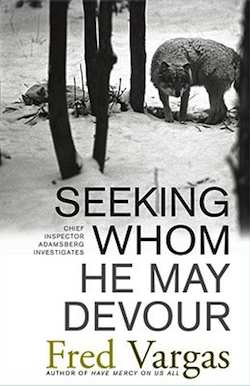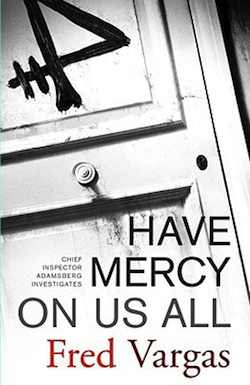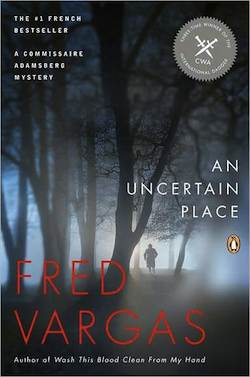
This, despite the fact that both had been translated into British English.
(See Stuart Evers’ post at the Guardian’s Books Blog for more about Vargas’ 3 CWA International Dagger Awards during the first 4 years of the prize’s existence, also about the switch from translator David Bellios of Have Mercy on Us All to Siân Reynolds, who takes over as of Seeking Whom He May Devour.)

Vargas’s Adamsberg novels are billed as thrillers—though the quirky characters, light tone, and subtle humor neutralize the menace that, to me at least, the word “thriller” implies. But the thrust is “catch him before he kills again.” Unless Adamsberg can figure out what’s going on, people will keep dying. Would-be mystery writers are often advised to provide a body in the first chapter; in Have Mercy on Us All, we have no body until Chapter 16.

Remember “The Murders in the Rue Morgue,” the first modern detective story? Poe launched the genre with a Connect-the-Dots puzzle. His crime scene features strands of hair pulled out by the roots, a corpse stuffed up a chimney, and four thousand francs in gold. Who would murder but not make off with such treasure? The door is locked from the inside, but neighbors report hearing voices, one gruff and one shrill.
Poe set “The Murders in the Rue Morgue” in Paris. This alone might have led Vargas to his work. But in fact Poe was immensely popular in France. Baudelaire made the first translation of his stories and, in Baudelaire’s translation, “The Murders in the Rue Morgue” appeared as the first story in the first volume. Poe’s use of the fantastic and grotesque appealed to the surrealists, but he also influenced French crime writers.
Perhaps Vargas learned from Poe how effectively readers are hooked by a puzzling setup. But it’s easy to puzzle readers. The challenge is to connect the dots in a believable way. Spoiler ahead—Poe’s culprit is an orangutan that climbed up the side of the building and through an open window. The window fell shut when the beast left. The voices were those of the orangutan and its owner, who climbed up after it and gazed through the window, aghast at the havoc the creature had wrought.
Does Vargas satisfactorily account for her puzzles? I can’t answer without spoiling two wonderful books. But here’s a clue: I’ll definitely seek out more of her work.
Noting the echo of Poe in Vargas’s plotting made me look more closely at Commissaire Adamsberg. He’s a marvelous creation, short and dark with tousled hair and a Columbo-like disregard for sartorial niceties. His distinctive trait as a crime solver is his disdain for method. Having collected all the data for a case, he spends long stretches of time leaning against the wall, walking aimlessly, or sketching pictures of his associates, while a “hazy idea” grows clearer in his mind. His technique has been characterized as intuitive, or zen-like.
This approach seems the exact opposite of a typical sleuth in a traditional mystery. Poe used the word “ratiocination,” from the Latin word for “reason,” to describe the process of crime-solving, and I’ve always taken that to mean he saw logic as key. Yet rereading “The Murders in the Rue Morgue” showed me that Poe’s Dupin and Vargas’s Adamsberg are brothers under the skin.

Did Vargas reach back to the mid-nineteenth century to find a prototype for her eccentric sleuth? It certainly seems possible.
Peggy Ehrhart is the author of the Maxx Maxwell mysteries, featuring blues-singer sleuth Elizabeth “Maxx” Maxwell. Visit Peggy on the web at www.PeggyEhrhart.com.

This sounds like a fascinating series and I love your comparisons between Adamsberg and Dupin.
I love this series. They are so delightfully french, old fashioned and yet modern as you detailed. They are also a refreshing change from the standard mystery format. You never know quite where these books will go, but the journey to where ever that may be is a true pleasure.
I’ve only read A Foul Night’s Work, but I really liked it, then forgot to read more. Back into the TBR corral with them. I find the squad’s strange way of working to be so interesting and unpredictable. I always like that slantways take.